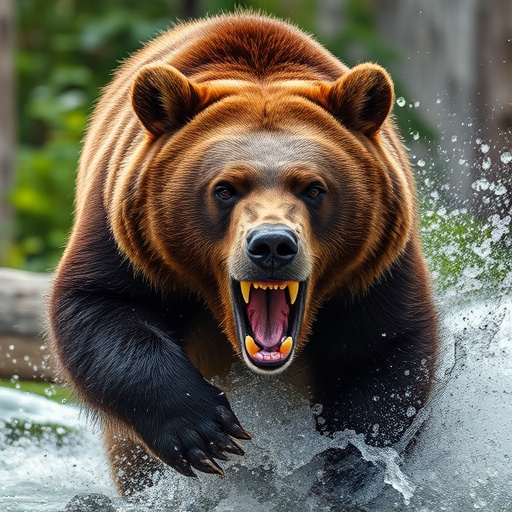Bear spray effectiveness depends on cloud dispersal dynamics, with finer droplets reaching further and affecting sensitive areas, disrupting bear behavior. The actual effective range is 15-20 feet, not 30 feet, focusing on creating distance for escape or deterring charges by targeting legs. Proper application technique is key; target eyes and face with quick bursts during an attack. Alternatives like noise makers, pepper spray, and reflective gear also disrupt bear charges within the bear spray cloud dispersal range of up to 30 feet.
“In regions where bear encounters are a reality, understanding the efficacy of deterrents like bear spray is paramount for safety. This article dissects the dynamics of bear spray clouds, exploring how these aerosolized defenses disperse and their effective range—busting myths along the way. We delve into the behavior of charging bears, the ideal spray application technique, and consider alternative solutions when bear spray might not be suitable. By understanding the science behind bear spray cloud dispersal and range, outdoor enthusiasts can make informed decisions to safeguard against potential bear encounters.”
- Bear Spray Cloud: Dispersal Dynamics
- Effective Range: Fact vs. Myth
- Charging Bears: Behavior and Response
- Spray Application: Technique and Timing
- Alternative Solutions: Beyond Bear Spray
Bear Spray Cloud: Dispersal Dynamics
The effectiveness of bear spray depends, in part, on its dispersal dynamics—how it spreads and lingers in the environment after being deployed. Bear spray forms a cloud when sprayed, with droplets ranging from fine to coarse aerosols. The finer droplets travel farther and stay suspended in the air for longer periods, creating a larger effective range against bears. These particles can reach and irritate a bear’s eyes, nose, mouth, and lungs, disrupting its behavior and giving humans valuable time to escape or defend themselves. In contrast, coarser droplets tend to settle more quickly but can still provide local protection. Understanding these dispersal patterns is crucial for users to ensure optimal coverage and maximum effectiveness during encounters with charging bears.
Effective Range: Fact vs. Myth
Many people believe that bear spray has an incredibly long effective range, often cited as up to 30 feet (9 meters). However, this is a myth; the actual effective range of bear spray is much shorter. The spray cloud dispersal typically reaches about 15-20 feet (4.5-6 meters) at most, depending on factors like the user’s movement and the can’s nozzle. This range is designed to create enough distance for the bear to lose interest or for the human to escape, but it’s not a weapon for long-distance defense against an aggressive bear.
Factually, bear spray works by irritating the bear’s eyes, nose, and respiratory system, causing it to flee. The key to its effectiveness lies in the proper application technique, not a far reach. Users should aim low, towards the bear’s legs and feet, to disrupt its balance and encourage retreat. Understanding this fact can help outdoorsmen and women navigate encounters with charging bears more effectively and safely.
Charging Bears: Behavior and Response
Charging bears, driven by instinct, often display aggressive behaviors that can be dangerous for humans in their path. When a bear perceives a potential threat or food source, it may charge as a means to protect itself or its cubs. The force of a bear’s charge can reach speeds up to 30 miles per hour (48 kilometers per hour), making it a formidable force.
Bear spray, when effectively deployed, plays a crucial role in deterring these charges. The cloud dispersal range of bear spray allows users to create a protective barrier by spraying into the air ahead of them. This disrupts the bear’s senses and vision, providing an opportunity for safe retreat or de-escalation of the situation. Understanding how bear spray interacts with a charging bear’s behavior is essential for hikers, campers, and outdoor enthusiasts navigating bear country.
Spray Application: Technique and Timing
The effectiveness of bear spray depends heavily on proper application. When faced with an attacking bear, aim for the eyes and face—this is where a bear spray cloud dispersal range of up to 30 feet comes into play.
Using quick, short bursts while maintaining a safe distance, allows you to create a disorienting spray cloud that can deter an approaching bear. Timing is crucial; apply the spray just as the bear begins to charge, aiming for maximum coverage on its sensitive facial areas.
Alternative Solutions: Beyond Bear Spray
While bear spray is widely recognized as an effective deterrent against charging bears, there are alternative solutions to consider, especially in situations where bear spray might not be readily available or its usage comes with limitations. One key aspect to understand is the bear spray cloud dispersal range. Effective deterrents must create a protective barrier that can disrupt a bear’s charge from a reasonable distance.
Beyond bear spray, some options include making noise to startle bears, carrying and using pepper spray designed for human self-defense (which may not always be suitable for wildlife encounters), or even specific clothing and gear designed with reflective materials to deter bears. It’s crucial to remember that each method has its effectiveness and limitations, and choosing the right tool depends on factors like the environment, bear behavior, and personal safety considerations.
Bear spray remains an effective tool for deterring charging bears, but understanding its dynamics—from cloud dispersal to optimal range—is crucial. By employing proper technique and timing, individuals can maximize the spray’s effectiveness during encounters. However, it’s important to note that no single solution guarantees safety; alternative measures should be considered as part of a comprehensive bear safety strategy.
